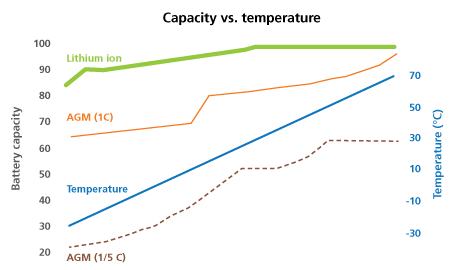- By Shawn Hatton
- May 31, 2020
- IIoT Insight
Summary
By Shawn Hatton
Extending control to the edge has great potential for reducing operational costs and improving efficiency, but it brings a host of new challenges, including ensuring power availability to all devices. Uninterruptible power supplies (UPSs), which provide battery backup for operations, are essential for all critical processes, and these are now evolving to deliver continuity in the digital age, beginning with their core battery technology.
Conventional UPSs use lead-acid absorbent glass mat (AGM) batteries, which are antiquated and have severe shortcomings. AGM lead batteries are large and heavy, must be vented, and must be mounted upright. Advancements in battery chemistry have decreased battery cell size without compromising output or efficiency, but these models have been slow to replace AGM batteries in the industrial world. This is changing rapidly, however, as UPS manufacturers replace lead-acid AGM technology with lithium-ion technology.
Lithium-ion technology has numerous advantages for backing up critical industrial processes. It has superior useable capacity and extended cycle life over lead-acid batteries, which is required for mission-critical applications.
AGM batteries typically use only 30 to 50 percent of their rated capacity. Discharging them below this limit greatly reduces their life. The (AGM) lead-acid pack must be limited to 30 percent depth of discharge (DoD) to get cycle life comparable to a lithium-ion that is used at 75 percent DoD. Moreover, the AGM battery must be 2.5 times larger in capacity than the lithium-ion to get comparable life.
Li-ion batteries also have the following advantages over AGM batteries:
- Flexible deployment: Li-ion units are sealed and can be mounted in any orientation.
- Fast charging: Li-ion units charge 10 times faster.
- Extended life: Li-ion units have a 12 amp-hour capacity and a 10-year life at 40ºC.
- Lower de-rate: Li-ion batteries can deliver 75 percent of their original capacity after 2000 charge cycles. AGM batteries are not suited for a continuous trickle-charge environment that is common in remote industrial installations. AGM batteries are dependent on a full depth of discharge to obtain the maximum amount of charge cycles.
- Improved capacity retention: Li-ion batteries operate across a wider temperature range with longer life. They maintain 100 percent of their load capacity between –10ºC to +50ºC versus 30 percent for AGM batteries (figure). Lead-acid batteries operate best at 25°C (77° F) and lose half of their life with every 8°C (15°F) rise in temperature. Even valve-regulated, lead-acid batteries, which are designed to maximize AGM efficiency, would last only 10 years at 25°C, five years at 33°C (95°F), and one year at 42°C (107°F). In hot regions, AGM-based UPSs typically need to be replaced every year.

Lithium needs protection as well
Despite the performance advantages of lithium over lead-acid, the UPSs need protection as well. Batteries consist of multiple cells, depending on how much power is needed. Rather than stack cells and monitor, control, and contain that stack, advanced Li-ion battery safety requires every cell to be engineered as an independent system. This starts with galvanic isolation of charging circuits and dedicated circuit boards, sensors, electronics, and passives to monitor, control, and limit charging current, charging voltage, and discharge current. In this way, the battery pack becomes less vulnerable to the status of a single cell, and the charge and discharge of each cell is independently optimized for safety and performance. The cells should be encapsulated and protected by multiple layers, including compliance with NEMA 4x, FIPS 140, and ingress protection (IP) standards from an all-metal housing.
Completing the package
With Li-ion technology at their core, UPSs are evolving in many other ways to optimize reliability at the edge. This includes improvements in intelligence, integration, ruggedness, and cybersecurity.
Embedding secure microcontrollers with high memory capacity enables collection and analysis of operational data, which can be used to identify and prevent critical errors, optimize performance, integrate with other technologies, and enforce authentication and encryption to protect the end device from cybersecurity threats.
Armed with advanced Li-ion technology, UPSs stand ready to meet the challenges of the digital age.
Reader Feedback
We want to hear from you! Please send us your comments and questions about this topic to InTechmagazine@isa.org.


